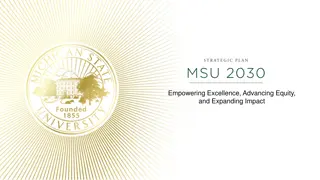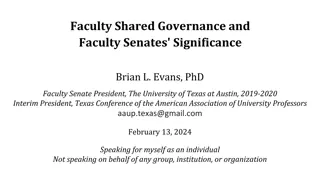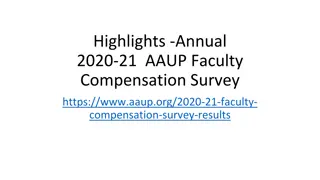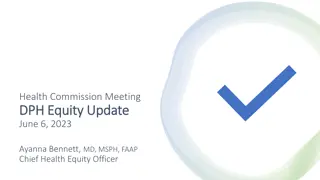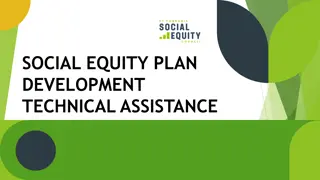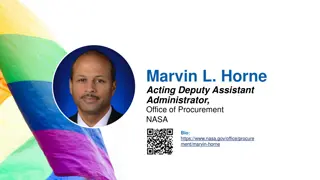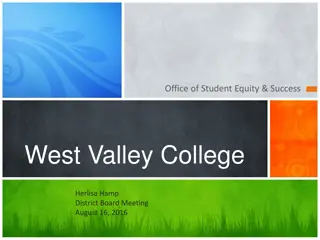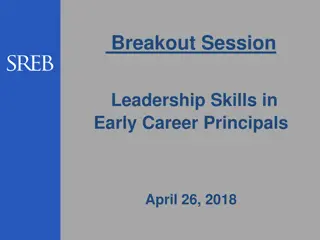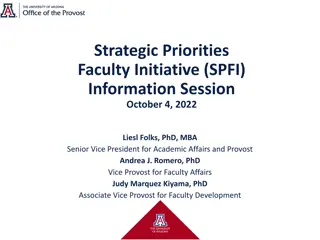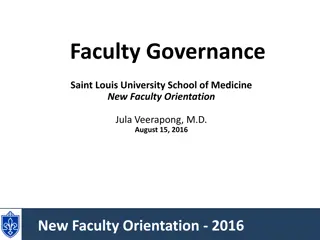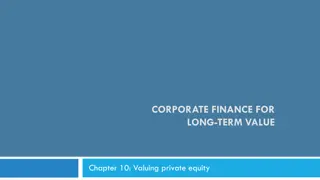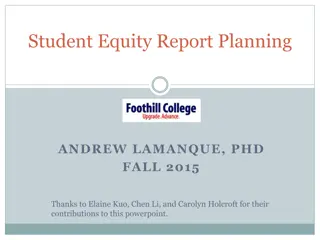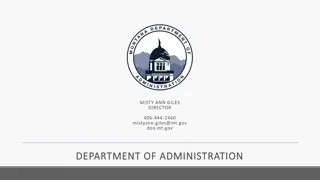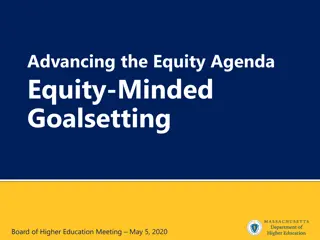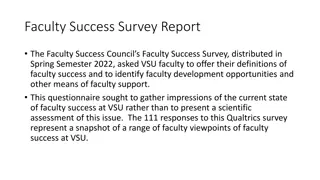
Achieving Educational Equity in Policy and Practice at Georgia State University
Explore the efforts of Ursula Thomas Ed.D., M.P.A. and Keisha Lanier Brown at Georgia State University in promoting equity in education. Discover the importance of equity in higher education, methods to evaluate it, and goals to bridge the equity gap in academic programs, faculty engagement, and policy shifts.
Download Presentation

Please find below an Image/Link to download the presentation.
The content on the website is provided AS IS for your information and personal use only. It may not be sold, licensed, or shared on other websites without obtaining consent from the author. If you encounter any issues during the download, it is possible that the publisher has removed the file from their server.
You are allowed to download the files provided on this website for personal or commercial use, subject to the condition that they are used lawfully. All files are the property of their respective owners.
The content on the website is provided AS IS for your information and personal use only. It may not be sold, licensed, or shared on other websites without obtaining consent from the author.
E N D
Presentation Transcript
FA C U LT Y L E A D E R S : G E T T I N G TO E Q U I T Y I N P O L I C Y A N D C L A S S RO O M P R A C T I C E U R S U L A T H O M A S , E D. D. , M . P. A K E I S H A L A N I E R B RO W N G E O R G I A S TAT E U N I V E R S I T Y P E R I M E T E R C O L L E G E
CONTACT INFORMATION Ursula Thomas Ed.D., M.P.A Associate Chair - Cultural and Behavioral Sciences Associate Professor of Education Affiliate Faculty of the Center for Equity and Justice in Teacher Education Primary Investigator- CCAMPIS Grant, USDOE Keisha Lanier Brown Associate Professor of Mathematics Perimeter College at Georgia State University Dunwoody Campus NE-2504 770-274-5576 klanier1@gsu.edu https://www.linkedin.com/in/keishalanier/ Perimeter College Georgia State University 555 N. Indian Creek Drive Clarkston, GA 30021 770-274-5401 uthomas3@gsu.edu www.linkedin.com/in/dr-ursula-thomas-565092a
WHAT IS EQUITY? THE WHY?
IS EQUITY IN HIGHER EDUCATION IMPORTANT? WHY OR WHY NOT? THE WHAT
HOW WOULD AN INSTITUTION EVALUATE ITS EQUITY EFFECTIVENESS? THE WHAT
Source: https://www.studentachievementsolutions.com/fighting-for-educational-equity-equity-vs-equality/
GOAL Our goal was to unpack the equity gap framework and investigate ways in which this work could lead to shifts in policy and new use of data. Most importantly, we wanted to engage faculty and academic programs to assist in addressing the equity gaps.
FRAMEWORK THE HOW
GOALS The diverse perspectives and issues in these projects will explicitly advance an equity agenda by: Utilizing empirical data to support equity-oriented practices starting from faculty classrooms and student-centered points of view (create tableau dashboards) 1. Contextualize 2. Utilize 3. Identify 4. Pinpoint 5. Unpack 6. Develop Identifying and mapping campus and college resources to support equity-oriented practices Providing examples of programming and practices that support the lives and livelihoods of underserved student populations Providing examples of policy, programming, and thinking that emphasize the role of the community college in expanding educational opportunities for underserved students. Developing SMART goals upon research captured in the framework.
Task Task Description Resources/Tools Time Completion Date frame July 15- August 28, 2022 Equity Dashboard Utilize empirical data to support equity-oriented practices starting from faculty classrooms and student centered points of view (create tableau dashboards) Identify and map campus and college resources to support equity-oriented practices, Tableau Reader dashboards Resource Identification College website and organization leadership chart College website September 1- November 31, 2022 December 1-January 31, 2022 Programming Examples of programming and practices that support the lives and livelihoods of underserved student populations, and Policy Examples of policy, programming, and thinking that emphasize the role of the community college in expanding educational opportunity for underserved students. SMART Goals Develop SMART goals upon research captured in the framework. Final Report Each participant will produce a white paper for presentation and submission. College website February 1-March 31, 2022 SMART Goals framework Template April 2022 April 28- May 30, 2022 May 1- June 30, 2022 Presentation Proposal The group facilitator will submit the presentation to three professional organizations. Presentation submission portals
BIBLIOGRAPHY Baker, D. J., Skinner, B. T., & Redding, C. H. (January 01, 2020). Affirmative Intervention to Reduce Stereotype Threat Bias: Experimental Evidence from a Community College. Journal of Higher Education, 91, 5, 722-754. Fabillar, E., & Education Development Center, Inc. (EDC). (2018). Systemic Equity Review Framework: A Practical Approach to Achieving High Educational Outcomes for All Students. Education Development Center, Inc. 55 Chapel Street, Newton, MA 02458-1060. Tel: 617-969- 7100; Fax: 617-969-5979; Web site: http://ltd.edc.org. Gilbert, C. K., & Heller, D. E. (January 01, 2013). Access, Equity, and Community Colleges: The Truman Commission and Federal Higher Education Policy from 1947 to 2011. The Journal of Higher Education, 84, 3, 417-443. Jakovljevic, M. (September 01, 2018). A model for innovation in higher education. South African Journal of Higher Education, 32, 4, 109-131. McKinney, L., & Hagedorn, L. S. (January 01, 2017). Performance-Based Funding for Community Colleges: Are Colleges Disadvantaged by Serving the Most Disadvantaged Students?. Journal of Higher Education, 88, 2, 159-182. Nakhaie, R. (January 01, 2013). Ideological Orientation of Professors and Equity Policies for Racialized Minorities. Canadian Ethnic Studies, 45, 43-68.
CASE STUDY: S T U D E N T S P E R C E P T I O N S A N D U S A G E O F T U T O R I N G I N M A T H E M A T I C S CONTEXT AND DEEP DIVE
RECRUITMENT Qualtrics Survey n = 151 IRB approval (H22508) Flyers on campus Math professors All faculty on each campus Jan. 22 Oct. 22
WHAT QUESTIONS DID I ASK? 1.) Please define what tutoring in mathematics means to you. 2.) What should tutoring look like? 3.) What can we do to encourage more students to attend tutorial in mathematics? 4.) Did you attend tutorial? YES NO Why did you decide to attend? Why did you decide not to go? What could have been done to motivate you to go? 5.) Demographic Questions This Photo by Unknown Author is licensed under CC BY
PLEASE DEFINE WHAT TUTORING IN MATHEMATICS MEANS TO YOU. Student 1: Help student better understand a concept which wasn t nurtured in class Student 2: Review concepts and material covered in class from a different perspective Student 3: Tutoring in Mathematics is like helping someone build a Lego house. Like passing a piece of Lego, I am passing on help in small bit so that the student can build their knowledge by themselves.
WHAT SHOULD TUTORING LOOK LIKE? Student 1: During Mathematics tutoring, the student in need of a tutor should be the one speaking the most, asking specific questions about what he or she did not understand and make sure they tell the tutor everything they are confused about. Student 2: Tutoring needs to be a two lane street. Tutors learn from their students through teaching them and they benefit from the tutoring process. Students benefit from learning new methods and styles. Both sides need to teach and have questions for each other. Student 3: a tutoring should look less like a normal class and more like a group project that each one helps in what they don't understand. Student 4: It should not be a lesson class but more over a brief summary of chapter then the student should be the one involved 90%.
Did you attend tutorial? Why or why not? 65 participants 53.8% (35) yes 46.2% (30) no (16) I was doing well already. (2) I didn't know how to access it. (17) Learn/I (5) The times were not convenient. (5) I did not think it would be helpful. (1) Learn/E (2) I did not have enough time to attend. (2) I did not feel like attending. (1) Learn/I/E (1) I had a bad experience.
LESSONS LEARNED Faculty Connect with students directly Give incentives Have tutors visit the classrooms Take your class to the tutoring center Submit students for the SI program Sympathize with students Have more office hours Decrease lecture, increase Q&A time Reach out early and often
LESSONS LEARNED Tutoring Centers Show students what to expect Advertise Have online tutoring Don't talk down to students Hire more tutors Have extended hours
LESSONS LEARNED LEARNING AND TUTORING CENTERS Students want to know what the session will look like. Students want to know where you are located. Students want to know who the tutors are. Source: https://www.youtube.com/watch?v=NtiZlz_w2NU
BIBLIOGRAPHY Abdul-Wahab, S. A., Salem, N. M., Yetilmezsoy, K., & Fadlallah, S. O. (2019). Students Reluctance to Attend Office Hours: Reasons and Suggested Solutions. Journal of Educational and Psychological Studies [JEPS], 13(4), 715. https://doi.org/10.24200/jeps.vol13iss4pp715-732 Ciscell, G., Foley, L., Luther, K., Howe, R., & Gjsedal, T. (2016). Barriers to Accessing Tutoring Services Among Students who Received a Mid- Semester Warning. Learning Assistance Review, 21(2), 39 54. Halcrow, C., & Iiams, M. (2011). You Can Build It, but Will They Come? PRIMUS, 21(4), 323 337. https://doi.org/10.1080/10511970903164148 Hodges, R. (2001). Encouraging High-Risk Student Participation in Tutoring and Supplemental Instruction. Journal of Developmental Education, 24(3), 2. Mitcham, L. G., Hsiao, E.-L., Leech, D. W., & Hull, K. M. (2020). Academic Success and Retention of Postsecondary Students Peer-Tutored in Mathematics. International Journal of Science, Mathematics & Technology Learning, 27(1), 37 52.
CONTACT INFORMATION Ursula Thomas Ed.D., M.P.A Associate Chair- Cultural and Behavioral Sciences Associate Professor of Education Affiliate Faculty of the Center for Equity and Justice in Teacher Education Primary Investigator- CCAMPIS Grant, USDOE Keisha Lanier Brown Associate Professor of Mathematics Perimeter College at Georgia State University Dunwoody Campus NE-2504 770-274-5576 klanier1@gsu.edu https://www.linkedin.com/in/keishalanier/ Perimeter College Georgia State University 555 N. Indian Creek Drive Clarkston, GA 30021 770-274-5401 uthomas3@gsu.edu www.linkedin.com/in/dr-ursula-thomas-565092a

